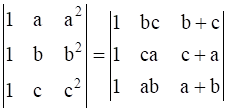Without expanding the determinant, prove that:

Operating R1→R1-R3, R2→R2-R3

→
Taking (a-c) and (b-c) common from R1, R2
→
Method 1:
If the determinants are equal, their difference must also be equal.
(a-c) and (b-c) get cancelled.



Since all elements of C1 are 0, by properties of determinants,
=0
∴ The 2 determinants are equal.
Method 2:
Expanding with C1
→(a-c)(b-c)(b+c-a-c) = (a-c)(b-c)(b-a)
→(a-c)(b-c)(b-a)=(a-c)(b-c)(b-a)
∴ RHS and LHS are equal
1